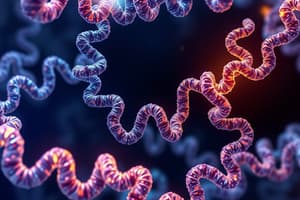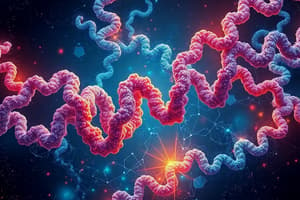Podcast
Questions and Answers
Which of the following structures represents the simplest form of protein structure?
Which of the following structures represents the simplest form of protein structure?
- Primary structure (correct)
- Quaternary structure
- Tertiary structure
- Secondary structure
What types of structures make up the secondary structure of proteins?
What types of structures make up the secondary structure of proteins?
- Gamma loops and beta sheets
- Primary chains and tertiary links
- Alpha helices and beta strands (correct)
- Folds and aggregates
What is a primary role of proteins in the body?
What is a primary role of proteins in the body?
- To store genetic information
- To transport oxygen
- To catalyze biochemical reactions (correct)
- To generate energy
What factor primarily determines the secondary structure of a protein?
What factor primarily determines the secondary structure of a protein?
Why is protein structure prediction crucial in bioinformatics?
Why is protein structure prediction crucial in bioinformatics?
Which of the following statements about tertiary and quaternary protein structures is true?
Which of the following statements about tertiary and quaternary protein structures is true?
Over how many years has protein structure prediction techniques developed?
Over how many years has protein structure prediction techniques developed?
What classification of protein structure follows primary and secondary structures?
What classification of protein structure follows primary and secondary structures?
What type of modeling does Biskit focus on?
What type of modeling does Biskit focus on?
Which software primarily emphasizes alignment strategy in protein modeling?
Which software primarily emphasizes alignment strategy in protein modeling?
Which software is considered the most accurate method for protein structure prediction?
Which software is considered the most accurate method for protein structure prediction?
What method does YASARA use that distinguishes it from traditional homology modeling?
What method does YASARA use that distinguishes it from traditional homology modeling?
Which software is established by IIT Delhi for tertiary protein structure prediction?
Which software is established by IIT Delhi for tertiary protein structure prediction?
What do protein threading and homology modeling primarily differ in?
What do protein threading and homology modeling primarily differ in?
Which feature is NOT included in the capabilities of the Prime software?
Which feature is NOT included in the capabilities of the Prime software?
What aspect of protein structure prediction does FoldX specialize in?
What aspect of protein structure prediction does FoldX specialize in?
What is the first step in the homology modeling process for protein structure prediction?
What is the first step in the homology modeling process for protein structure prediction?
Which of the following best describes protein threading?
Which of the following best describes protein threading?
Which step follows template selection in the homology modeling process?
Which step follows template selection in the homology modeling process?
Which of the following is NOT a method involved in homology modeling?
Which of the following is NOT a method involved in homology modeling?
What aspect of homology modeling is emphasized in drug discovery?
What aspect of homology modeling is emphasized in drug discovery?
Which of the following techniques is specifically mentioned as a model used in homology modeling?
Which of the following techniques is specifically mentioned as a model used in homology modeling?
What is the final step in the homology modeling process?
What is the final step in the homology modeling process?
What is a common characteristic of most homology modeling techniques available in the market?
What is a common characteristic of most homology modeling techniques available in the market?
What does the library of core fold templates represent?
What does the library of core fold templates represent?
Which step follows the successful alignment of the target sequence and template fold?
Which step follows the successful alignment of the target sequence and template fold?
What is one of the main challenges in finding the best template for protein alignment?
What is one of the main challenges in finding the best template for protein alignment?
Which computational method is NOT mentioned as a combinatorial optimized approach for protein threading?
Which computational method is NOT mentioned as a combinatorial optimized approach for protein threading?
What is evaluated based on statistical significance during the protein structure prediction process?
What is evaluated based on statistical significance during the protein structure prediction process?
Which term describes the model that is built using a comparative approach?
Which term describes the model that is built using a comparative approach?
What happens if the aligned amino acid sequence is very low?
What happens if the aligned amino acid sequence is very low?
Which of the following is a key element in computational modelling of target proteins?
Which of the following is a key element in computational modelling of target proteins?
What initiates the folding structure of a globular protein?
What initiates the folding structure of a globular protein?
Which of the following techniques is NOT commonly used to determine the three-dimensional structure of proteins?
Which of the following techniques is NOT commonly used to determine the three-dimensional structure of proteins?
Which strategy is part of the computational methods for protein structure prediction?
Which strategy is part of the computational methods for protein structure prediction?
What does the quaternary structure of a protein involve?
What does the quaternary structure of a protein involve?
Why is the knowledge of primary protein structure often insufficient?
Why is the knowledge of primary protein structure often insufficient?
What is a major challenge in protein structure prediction?
What is a major challenge in protein structure prediction?
Which aspect is crucial for understanding a protein's function?
Which aspect is crucial for understanding a protein's function?
What is the role of computational methods in protein structure prediction?
What is the role of computational methods in protein structure prediction?
Flashcards are hidden until you start studying
Study Notes
Introduction to Protein Structure
- Proteins are essential biological molecules responsible for physiological and biochemical reactions in living organisms.
- Understanding protein structure is crucial for drug design, medicinal applications, and bio-industrial applications.
- Predicting protein structure has evolved over 25 years, primarily through computational methods.
- Four levels of protein structure exist: primary, secondary, tertiary, and quaternary.
Types of Protein Structure
- Primary Structure: Linear sequence of amino acids.
- Secondary Structure: Formation of alpha helices and beta sheets through hydrogen bonds between amino acids.
- Tertiary Structure: Three-dimensional folding due to bonds such as hydrophobic interactions, disulfide bridges, and hydrogen bonds.
- Quaternary Structure: Assembly of multiple polypeptide chains stabilized by non-covalent interactions.
Importance of Protein Structure Prediction
- Accurate protein structure prediction aids in understanding protein function.
- A correct conformation is necessary for efficient protein activity.
- Knowledge of amino acid sequences is pivotal but insufficient without structural context.
Techniques for Determining Protein Structure
- Common experimental methods include:
- Electron microscopy
- Spectroscopy
- X-ray crystallography
- Nuclear magnetic resonance (NMR)
Computational Methods for Protein Structure Prediction
- Three primary computational strategies:
- Homology Modelling
- Protein Threading (Protein Fold Recognition)
- Ab Initio (de novo) Techniques
Homology Modelling
- Involves creating models based on known structures of similar proteins.
- Steps include:
- Template selection
- Sequence alignment
- Structural model construction and optimization
- Software tools for homology modelling include:
- RaptorX: 3D modelling and binding site prediction.
- MODELLER: Builds tertiary and quaternary structures.
- SWISS-MODEL: Highly accurate for protein structure prediction.
Protein Threading
- Identifies target protein structures by aligning with known folds from established protein databases.
- Involves:
- Core fold template library creation.
- Compatibility evaluation between sequences and templates.
- Statistical optimization for the best-fit model.
- Challenges include limited data in protein databases and complex folding interactions.
Key Factors in Protein Folding
- Interaction types influencing protein folding:
- Hydrogen bonds
- Hydrophobic interactions
- Van der Waals forces
- Electrostatic forces
- Approximately 1300 different protein folds are known, with new ones being discovered annually.
Software and Tools for Protein Prediction
- Significant threading software includes:
- HHpred: Template detection and 3D modelling.
- Phyre: Popular for alignment and modelling using multiple templates.
Conclusion on Computational Methods
- Computational methods provide essential strategies for addressing challenges in protein structure prediction.
- Advances in algorithms and software are critical for improving accuracy and efficiency in predicting protein structures.
Studying That Suits You
Use AI to generate personalized quizzes and flashcards to suit your learning preferences.




